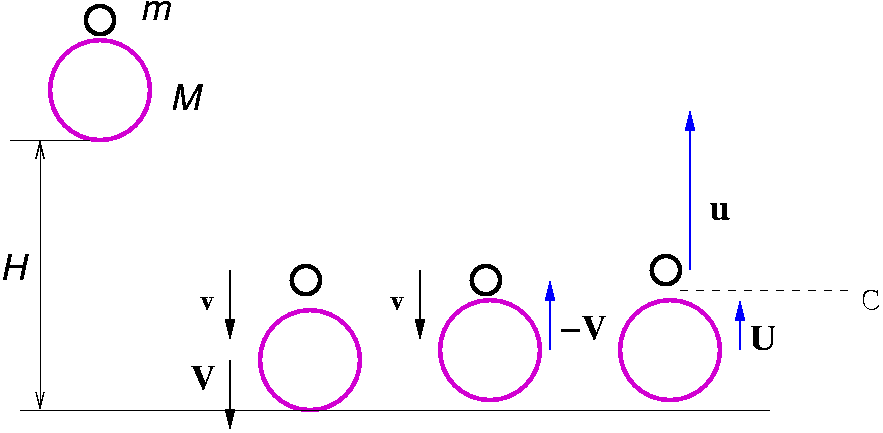A
For a printer-friendly version of this text please use the PDF version. Two pages, 50kbytes.
This document deals with the Physics (actually, the Math) of an experiment demonstrated during the lecture.
By popular demand (read: when I asked about it in the tutorials none of you tried to do the problem!) I thought that posting the solution would be of some help.
The setup (re: D. Harrison demonstration) is:
A ![]() tennis ball is held above a
tennis ball is held above a ![]() basketball,
and both are released from rest when the bottom of the basketball
is
basketball,
and both are released from rest when the bottom of the basketball
is ![]() above the ground.
Assume the basketball instantaneously reverses
its velocity when it hits the ground and that at
this moment the tennis ball is still moving down. The basketball
then collides with the tennis ball, causing it to rebound.
How high does the
tennis ball go?
above the ground.
Assume the basketball instantaneously reverses
its velocity when it hits the ground and that at
this moment the tennis ball is still moving down. The basketball
then collides with the tennis ball, causing it to rebound.
How high does the
tennis ball go?
In what follow I am presenting the calculation of the bouncing height for the tennis ball.
First, here is a picture of the setup.

On the diagram, ![]() are the masses of the balls,
are the masses of the balls, ![]() is the height (note that both balls fall the same distance,
is the height (note that both balls fall the same distance, ![]() ,
assuming negligible deformations during the impacts!),
,
assuming negligible deformations during the impacts!),
![]() , and
, and
![]() are the velocities of
are the velocities of ![]() and
and ![]() before, and after the collision, respectively.
Note the use of boldface, instead of
before, and after the collision, respectively.
Note the use of boldface, instead of ![]() to denote vectors
on the diagram.
to denote vectors
on the diagram.
To simplify our lives, let us assume the collisions are perfectly elastic.
Hence, the kinetic energy is conserved. Total momentum of
the (tennis ball + basketball) system
is conserved
during the collision
(true if one assumes, reasonably, that the impulse of external forces
acting on the system is negligible
during the collision time).
The momentum conservation for the whole system
right before and right after the collision gives
Now, let us choose ``upward'' to be the positive direction
for the velocities.
Then, equation (1) gives us
The sign ofis not known ``a priori'', and the sign of
is also not known, but for
we assume it is
for the problem to make sense). At the end, if we obtain a positive quantity for
then we know having
was OK. If not, well, it means the basketball moved the other way.
For now we are interested in ![]() but not
but not ![]() . Let's get rid of
. Let's get rid of ![]() ,
by expressing it from (3) and substituting
into (2).
We have
,
by expressing it from (3) and substituting
into (2).
We have
N.B. Introducingmakes the ``picture'' cleaner and clearer, and calculations less prone to errors. Besides, in this problem
is the parameter of interest -
rules.
Finally, by dividing through with ![]() in (2)
and using (4) one obtains
in (2)
and using (4) one obtains
| (6) |
| (7) |
| (8) |
In our case
![]() , and
, and
![]() .
.
Since in the gravitational context (free fall,
potential/kinetic energy) the height
scales as the square of velocity, we have ![]() and
and ![]() .
.
Of course, you can do it the old way
(no need for ``![]() '' arguments ...); once you have the
value of
'' arguments ...); once you have the
value of ![]() , the height tennis ball reaches is given by
, the height tennis ball reaches is given by
![]() (use Galileo's formula, for example).
(use Galileo's formula, for example).
Oops, I forgot to mentionis the height to which the tennis ball rebounced after collision -
is measured relative to the collision point, i.e. level ``C'' on the diagram).
Therefore,
 . With
. With ![]() we get
we get
![]() . Impressive!
. Impressive!
N.B. There is a danger lurking in this quicky scaling solution. Notice that forthe quantity in the parentheses in the last expression becomes negative. For such values of
the problem doesn't make sense - the tennis ball doesn't bounce back! Do it the ``old way'' to convince yourself of this. The scaling should have read in fact
, which makes it obvious that something is wrong if
.
Revised: 10/21/05 © 2005 Sorin Codoban